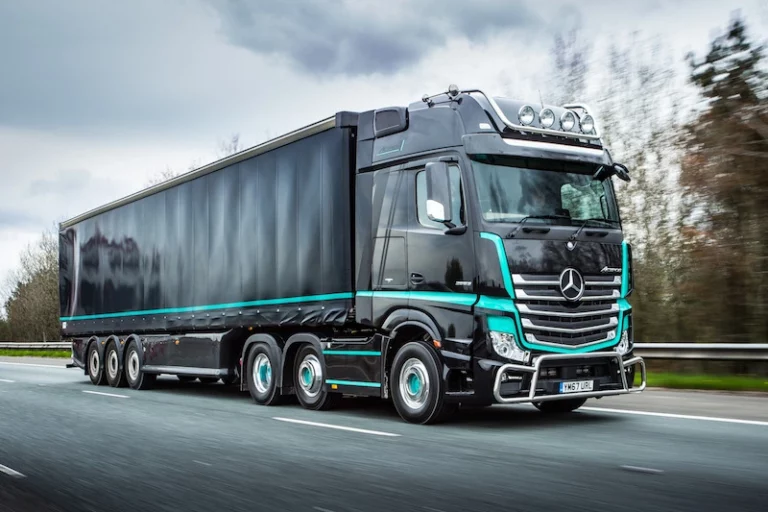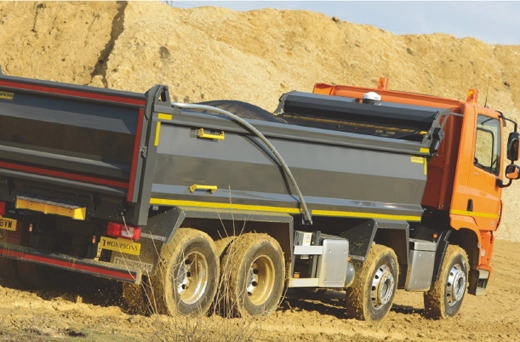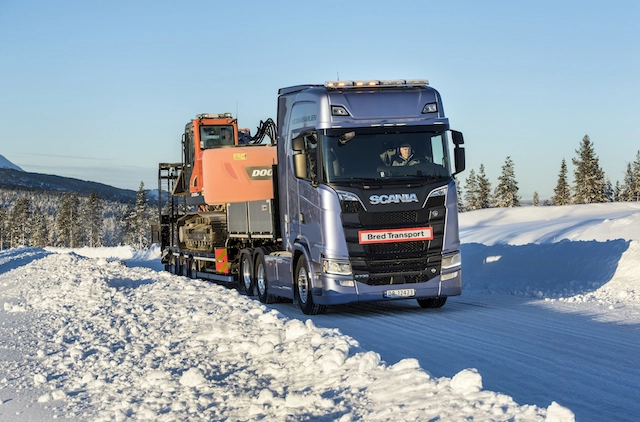The Mercedes-Benz Mp4 Actros is one of the most significant trucks in the company’s history. It’s hard to believe the earliest examples are now six years old – but now Actros1 is here with an upgraded load-out.
Of all the truck makers over the last decade, it’s the Stuttgart-based giants that really nailed it with the styling. Whatever your opinion on the truck itself, the Actros looks brilliant, even today. You’ll hear no talk of “needs a strong livery” or “what are those bits of plastic?” or “it’s like an ERF ECX” here.
Much of the success enjoyed by the Actros has been down to its popularity with, well, pretty much everyone. The super-fleets like them, as do family firms. There is a bewildering array of cab sizes and engine options. The Actros does everything from pee-wee parcel-pullers to colossal heavy-haulage outfits, but the mainstays of the range are the full-size StreamSpace, BigSpace and GigaSpace tractor units.
As smart as they look, these Actros have never been universally praised for their driver appeal. The truck has forged a strong reputation for reliability and fuel economy among operators, but from a driver’s point of view the Actros tends to be fairly strongly liked or disliked. The six-pot engines can feel underpowered until you’re over the 500 bhp mark, and the Powershift gearbox – a common cause of griping from drivers – has never been able to match the slick-shifting of an I-Shift or Opticruise.
A shot in the arm
What the Actros has been needing is a shot in the arm, a special edition to show off what it can really do. The Actros1 is aimed at the likes of owner-operators/small fleets who might otherwise be contemplating something Swedish, and big-boys who want a flagship/reward for a loyal driver. It’s putting a marker down squarely in Scania V8 territory, and Mercedes-Benz will be hoping the halo effect will pull the rest of the range along with it.
There aren’t too many 630 bhp Actros on our roads just now, but the new ‘1’ is looking to change that. This is the top output available from the 15.6-litre OM 473 LA engine. The limited-edition truck is also available with a 530 bhp 12.8-litre engine. The thing about big engines on regular 44-tonne work is they’re completely unstressed. Not only can they provide shorter journey times in hilly regions, but the fuel economy is often no worse, or even better than a no-frills 450. It’s worth stressing, though, that big-power trucks need responsible drivers to get the best from them. For STGO work, the Actros1 is designed to operate at 68 tonnes, although it’s available as a midlift only.
Today, with the driver shortage what it is, companies are increasingly looking to up-spec trucks to make them more attractive to, and therefore help retain, good drivers. Back in 2012 when the Actros launched, 450 bhp was the norm. Now you’re just as likely to see 480s or 510s – and its the same for all the other manufacturers. Up-spec’ing isn’t just about the drivers though; it’s also about residual values. We’ve mentioned it a number of times in Truck on Trial. A smart 500+ with a big cab and some extras is just so much nicer for everyone concerned that even trunk fleets who don’t do nights out are going for them.
On the road
We had the opportunity to drive the new Actros1 from Gretna, at the Scottish border, up through Moffat on the A701, looping back round and picking up the M74 again. The last Actros I drove was for work, about 18 months ago. It was a 510 GigaSpace on supermarket deliveries and I remember it being a substantial improvement on the Euro 5 450s I spent a lot of time driving in 2013-14. Climbing up the many steps into the cab, the Actros1 sports a pretty much identical dash. The main differences are the luxurious leather seats, a set of rear lockers and a modern stereo with full colour touchscreen, DAB and sat nav.
For a truck with so much in-built technology, the Actros is easy to get to grips with. I remembered how to scroll through the dash menus using the steering wheel buttons, and connecting my phone to the Bluetooth took seconds. On the older Actros, I found the driver seat to be set too high – your legs would be visible from the side window. I’d have to drive with the seat on the floor, air dropped, which was annoying. The Actros1 is much better. I was able to set the seat just how I wanted it with the air controls.
The dash itself is well built, but it’s a shame its clad in plain black plastic, with a touch of grey. Some fake wood or brushed metal would really improve the looks. Selecting gear couldn’t be easier, using the stalk on the right. I’ve previously found the auto ’box to be one of the weaker points on the Actros, but the latest revisions for Euro 6 Step C have seen improvements made to the software and the speed in which the gears shift. We shuttled up the ratios smoothly, and the need to downshift was dealt with quickly – not that the engine was ever struggling.
Curiously, the truck is low-geared, especially when taking into account the down-speeding strategy that’s been rolled out by manufacturers for the latest Euro 6 updates. Almost 1400 rpm on the limiter? It’s a strange one, especially considering the amount of torque available. Worth bearing in mind if you’re spec’ing a new one.
Easy rider
Winding our way though the busy town of Moffat, the Actros slumbered along, barely above tickover. The gearbox was responsive to light touch on the throttle, keeping the revs low and shifting up early at low speeds. With 3000 Nm of torque at 1000 rpm, it was easy to forget the trailer full of concrete ballast weighing us down at almost 44 tonnes gross. Climbing the hill out of town, the transmission had the good sense to hold ratios on inclines, not taking my lifting of the throttle on a corner as an excuse to upshift.
It’s effortless, and what’s also pleasing is the noise of the engine. It sounds like you’ve got a big, powerful diesel engine under the floor. Which is good, because you do.
As we began to drop down some steep inclines, the engine brake came into play. I’ve found in the past that the Actros would have the annoying habit of dropping three ratios and booting ninth gear right in the spuds when you go for full engine brake power. As with the rest of the gear shifting, this seems to have been refined, with the downshifting under braking better controlled. At no point did I have to contemplate using manual transmission mode. There is a Power mode available through the transmission which will temporarily employ a more aggressive shift strategy, but I doubt you’d ever need it at 44 tonnes.
Overall, I was impressed with how much better integrated the transmission was: it feels like it’s working in harmony with the driver, rather than you getting into arguments with it.
Feeling tyred
The steering was on the heavy side, but that’ll be due to the substantial super single tyres on the drive axle – they look smart but don’t help the front suspension, which gets upset by potholes more than some. I do still get the impression that you sit on top of an Actros, rather than in it. The cab still feels like it rolls a bit on corners – if the cab must be mounted so high, then there’s going to be a compromise somewhere.
When it came to parking up the truck, throttle response when reversing was a touch sticky, but better than previous examples we’ve tried; there’s a crawler mode which is enabled via the dash menus for manoeuvring. Make sure that it is.
Now, considering the sheer size of the Actros, you’d think the cab would be equally as enormous. But it isn’t, and the interior isn’t particularly innovative. The floor is so high that the inside isn’t as big as you might think. Don’t get me wrong, it’s spacious. The rear lockers provided here help with storage space enormously. The microwave is located here, leaving the front overheads free. There’s a big comfy premium mattress, and you even get some Actros1 bedding included in, er, beige and white. It’s all nice, but it lacks the clever touches of some rivals. The stereo, though, is absolutely banging. With seven speakers and a subwoofer, you could hold your own private rave in there.
VERDICT
If the Actros1 is all about pushing the range upmarket, planting seeds and showing what the truck can really do, then it succeeds. It can sit confidently alongside any prestige high-output rival and hold its head high. This does feel special, and the Actros looks as fresh as ever on the outside. The seats are fantastic, but the interior could do with a facelift.




